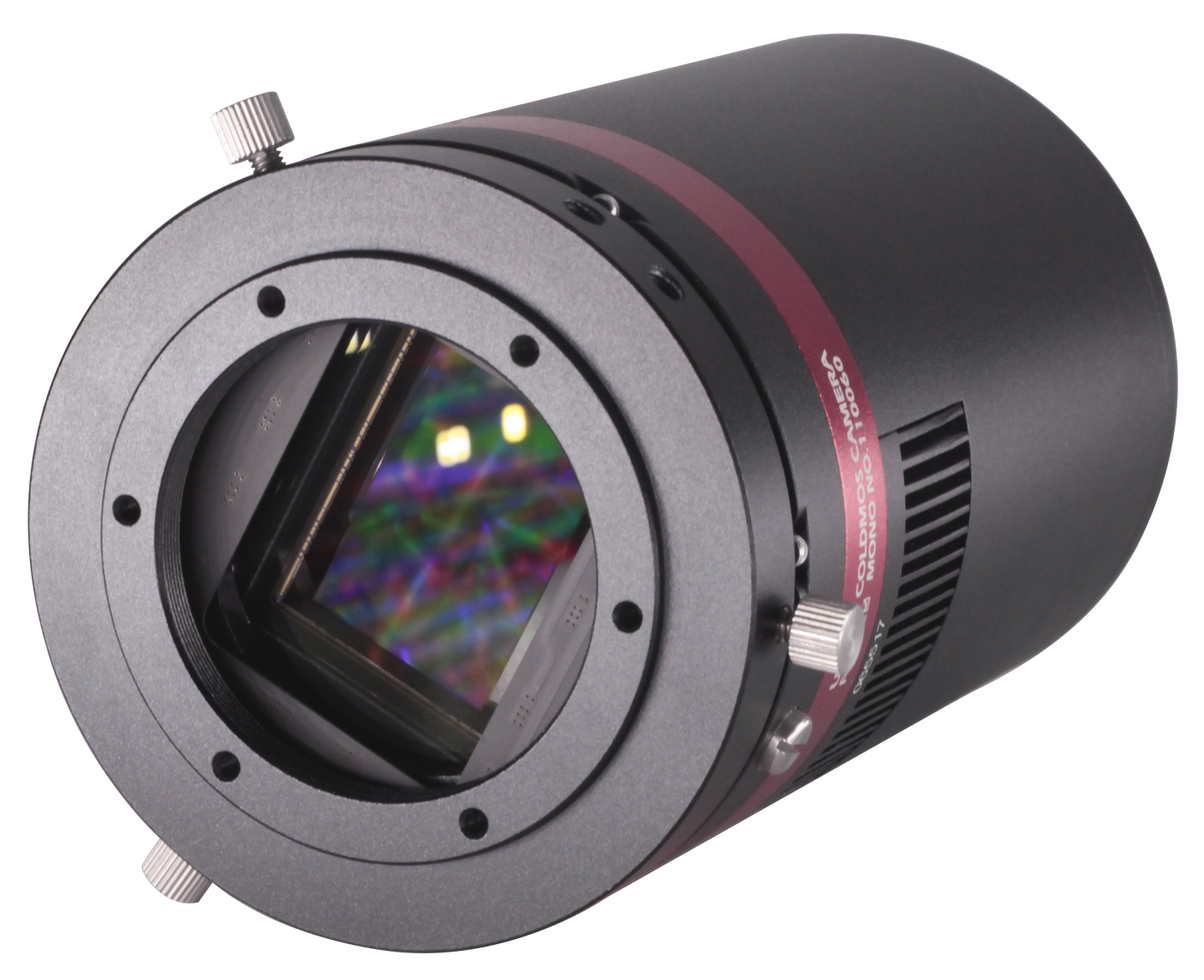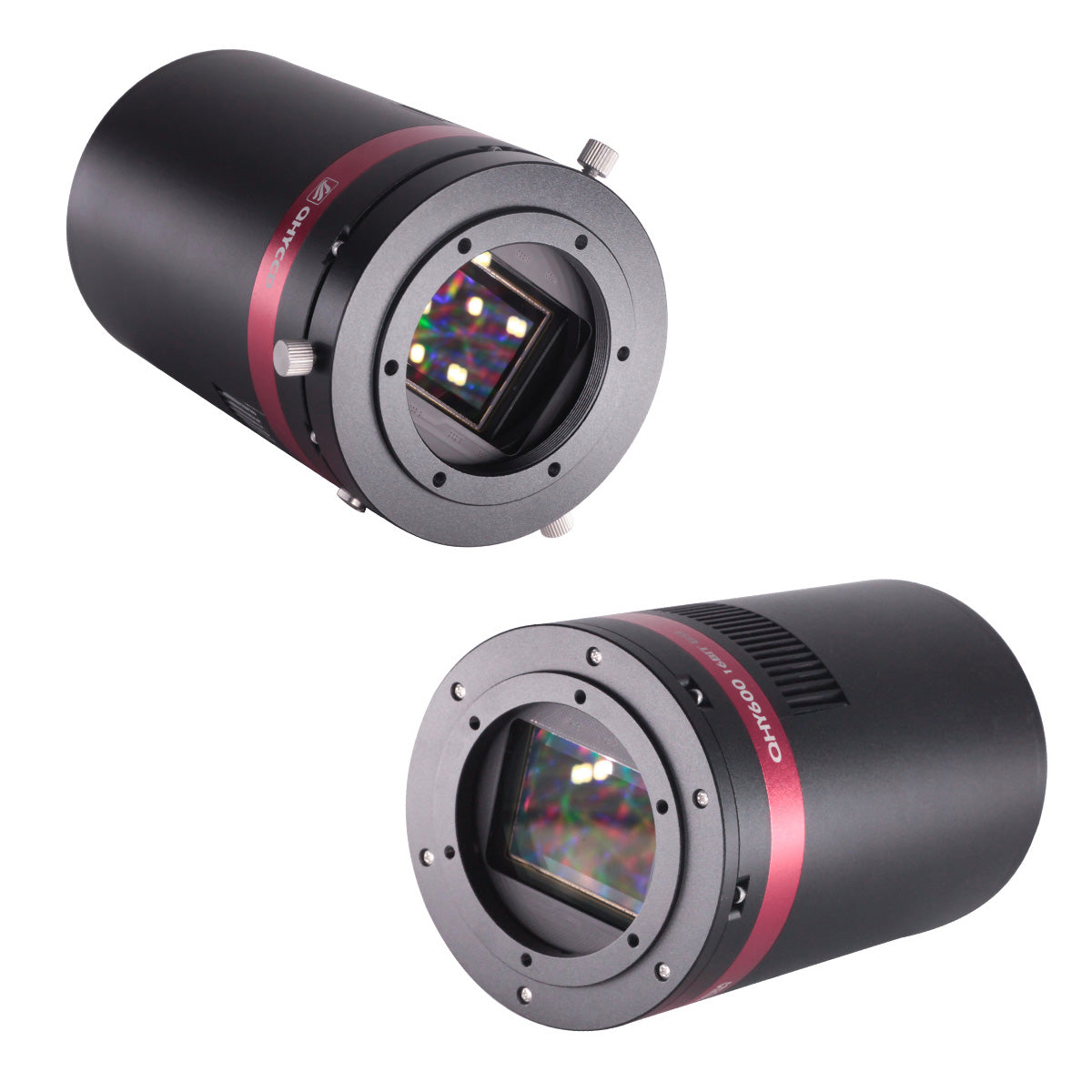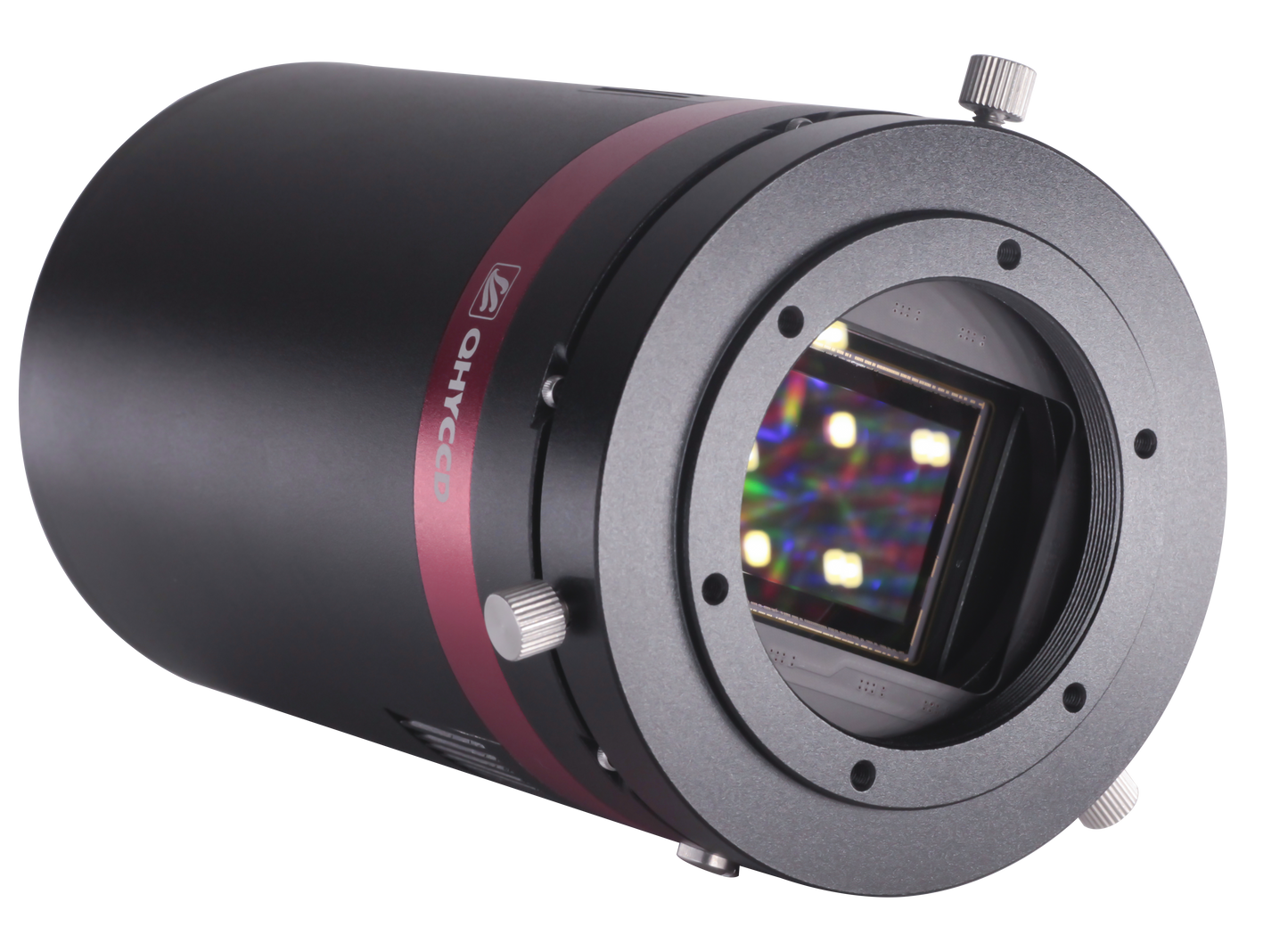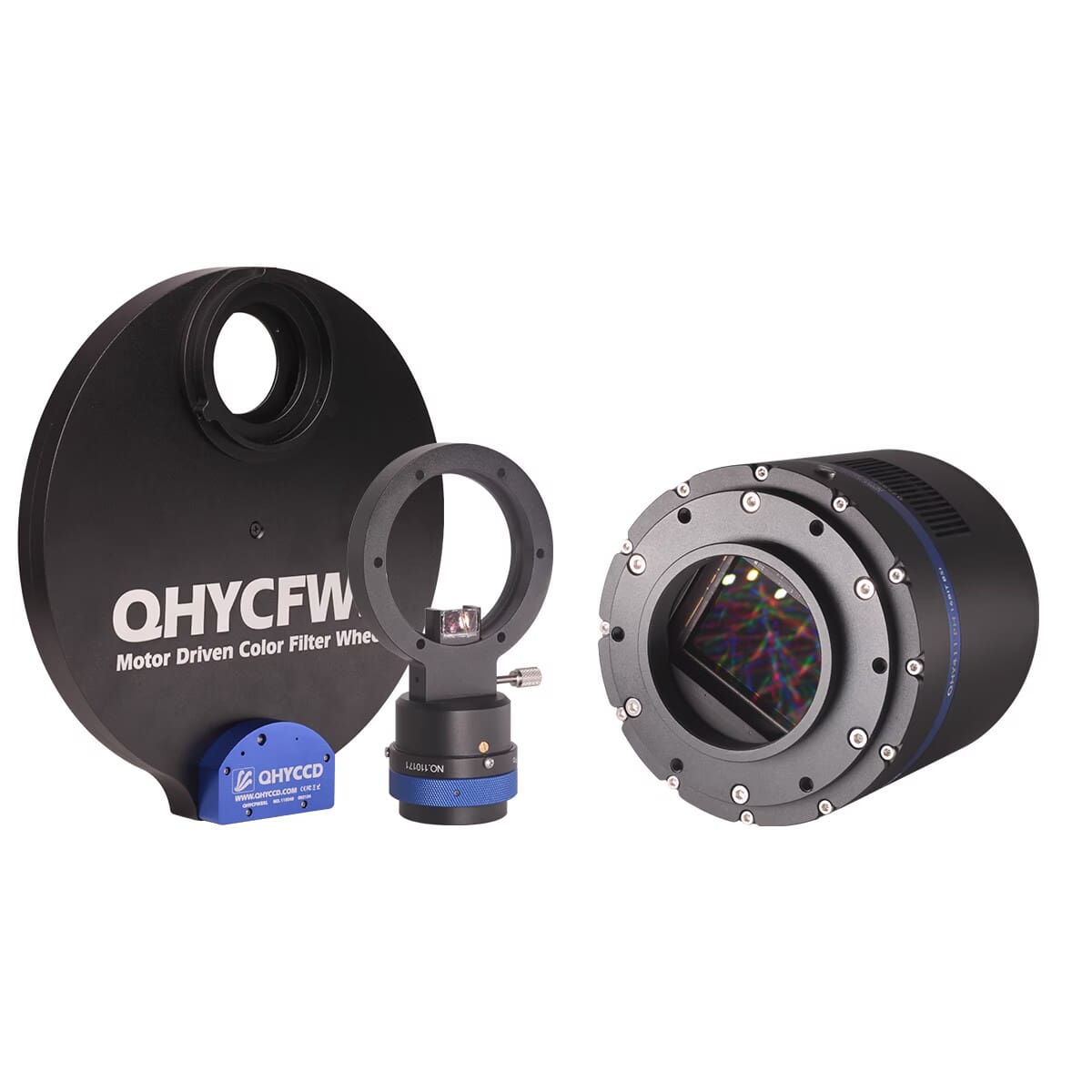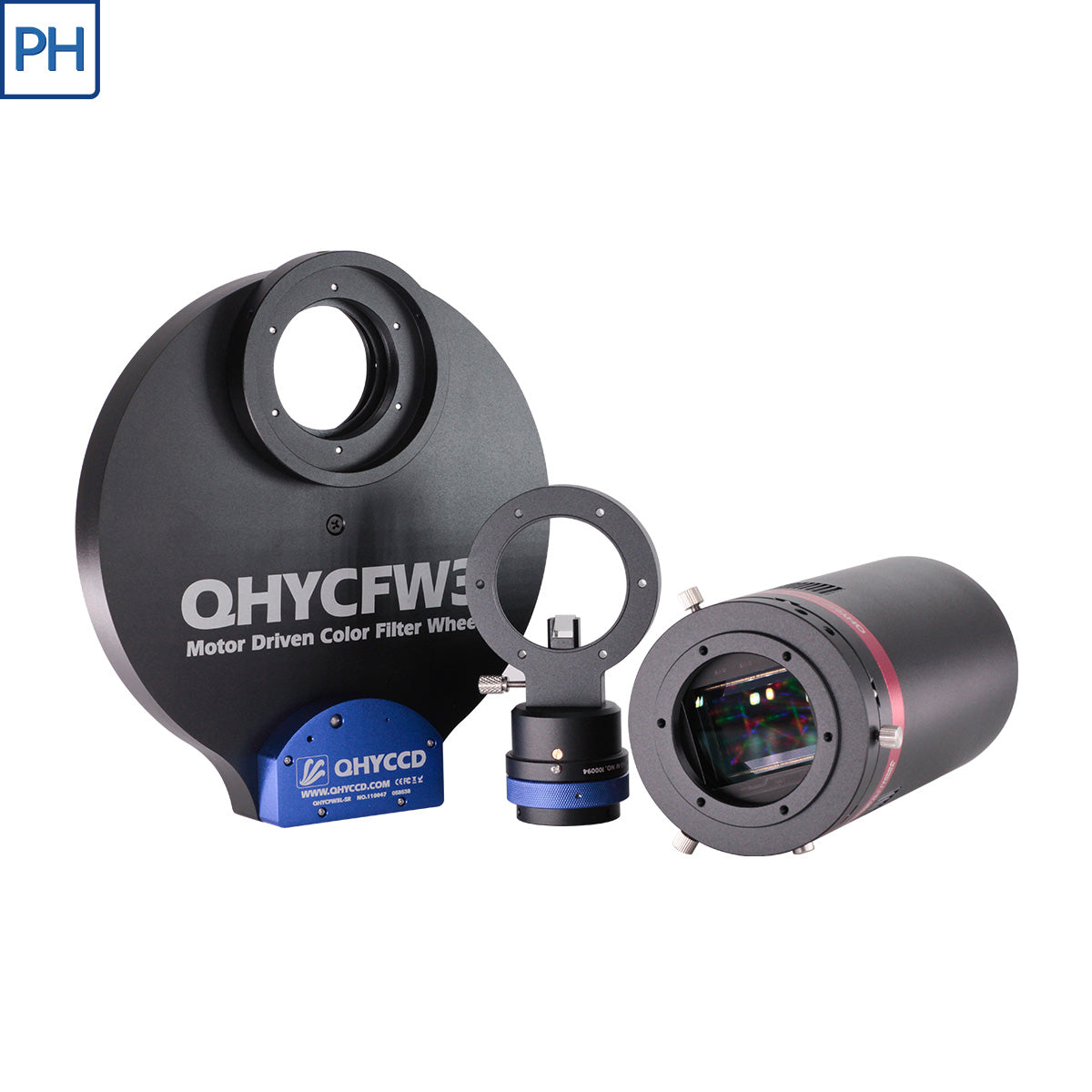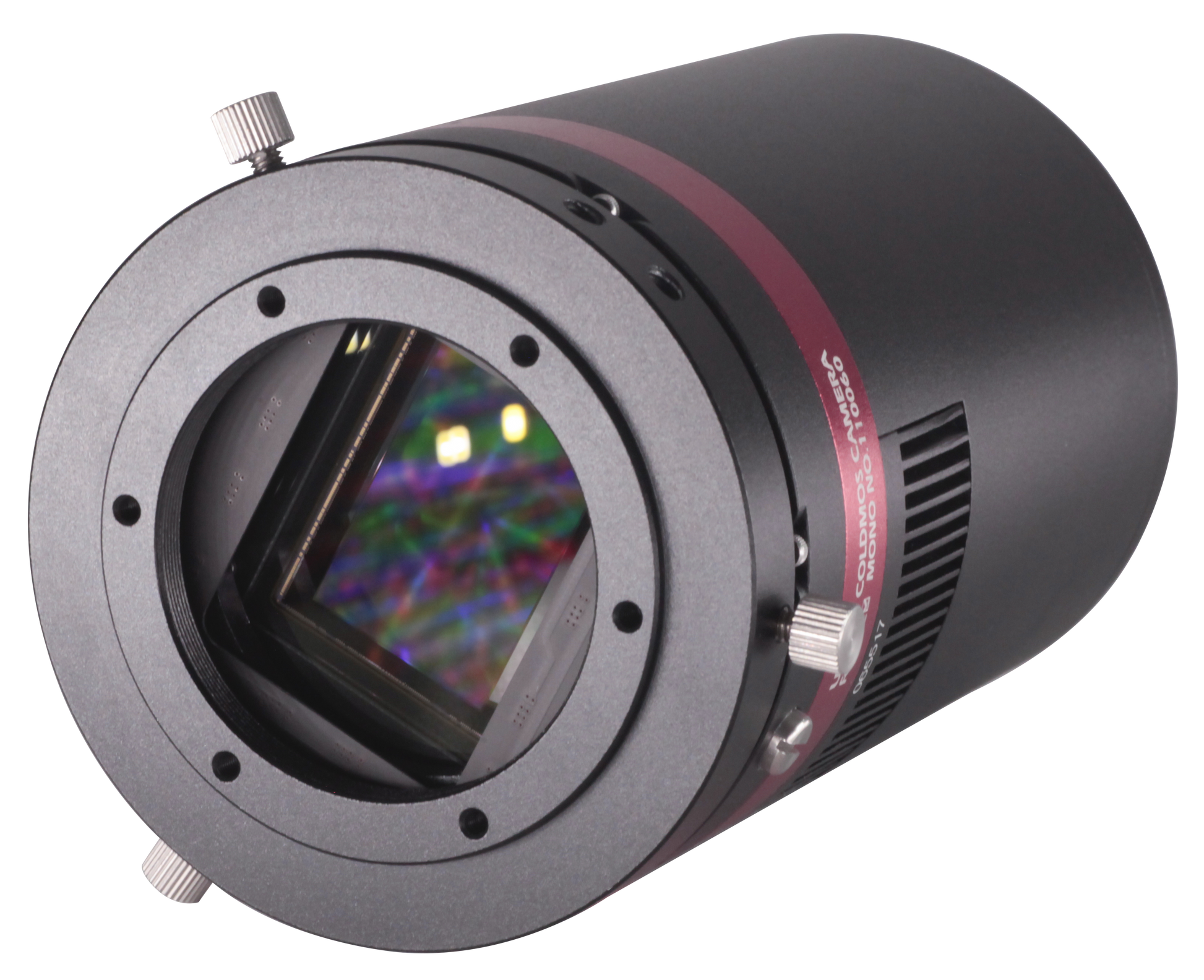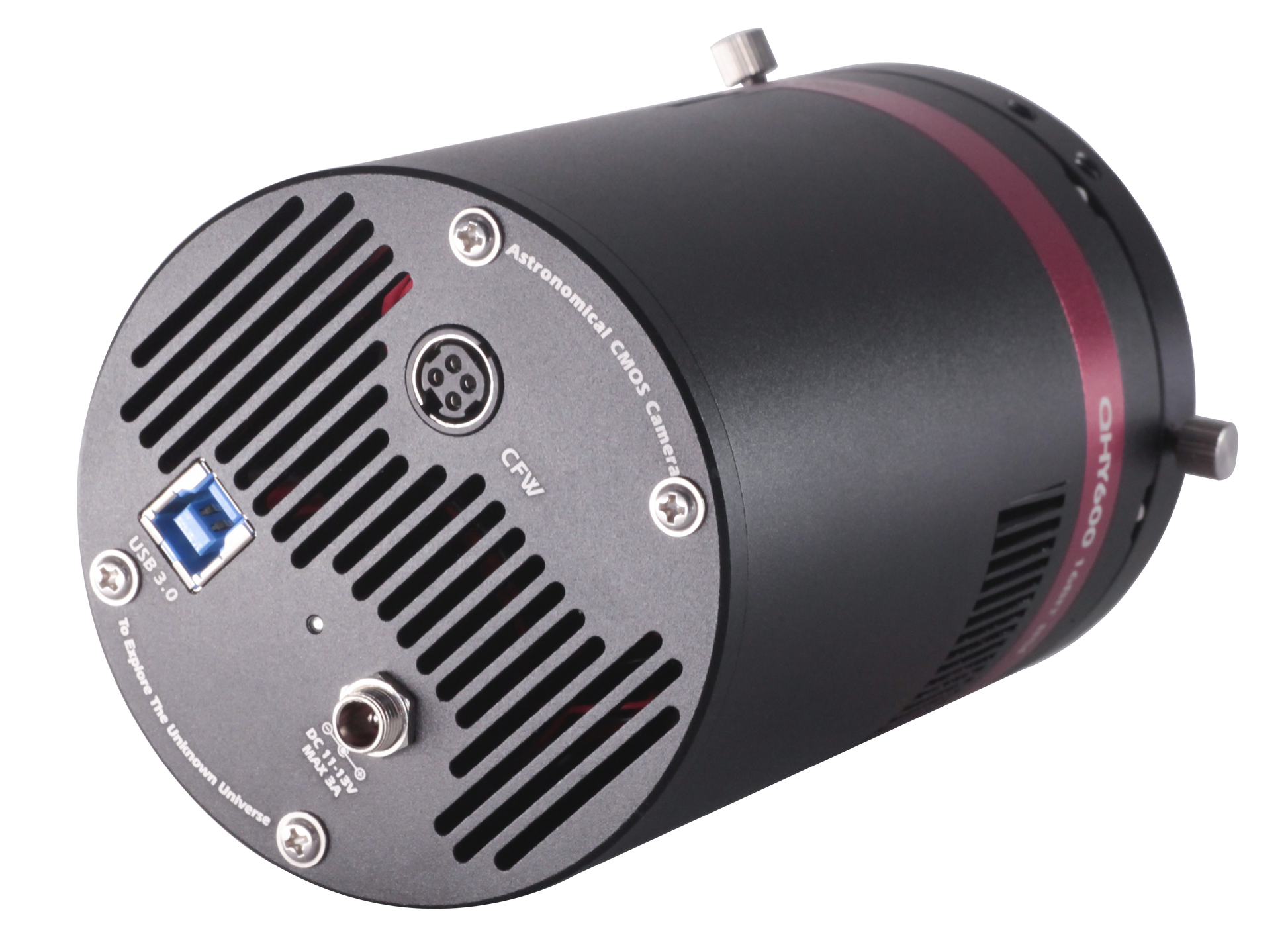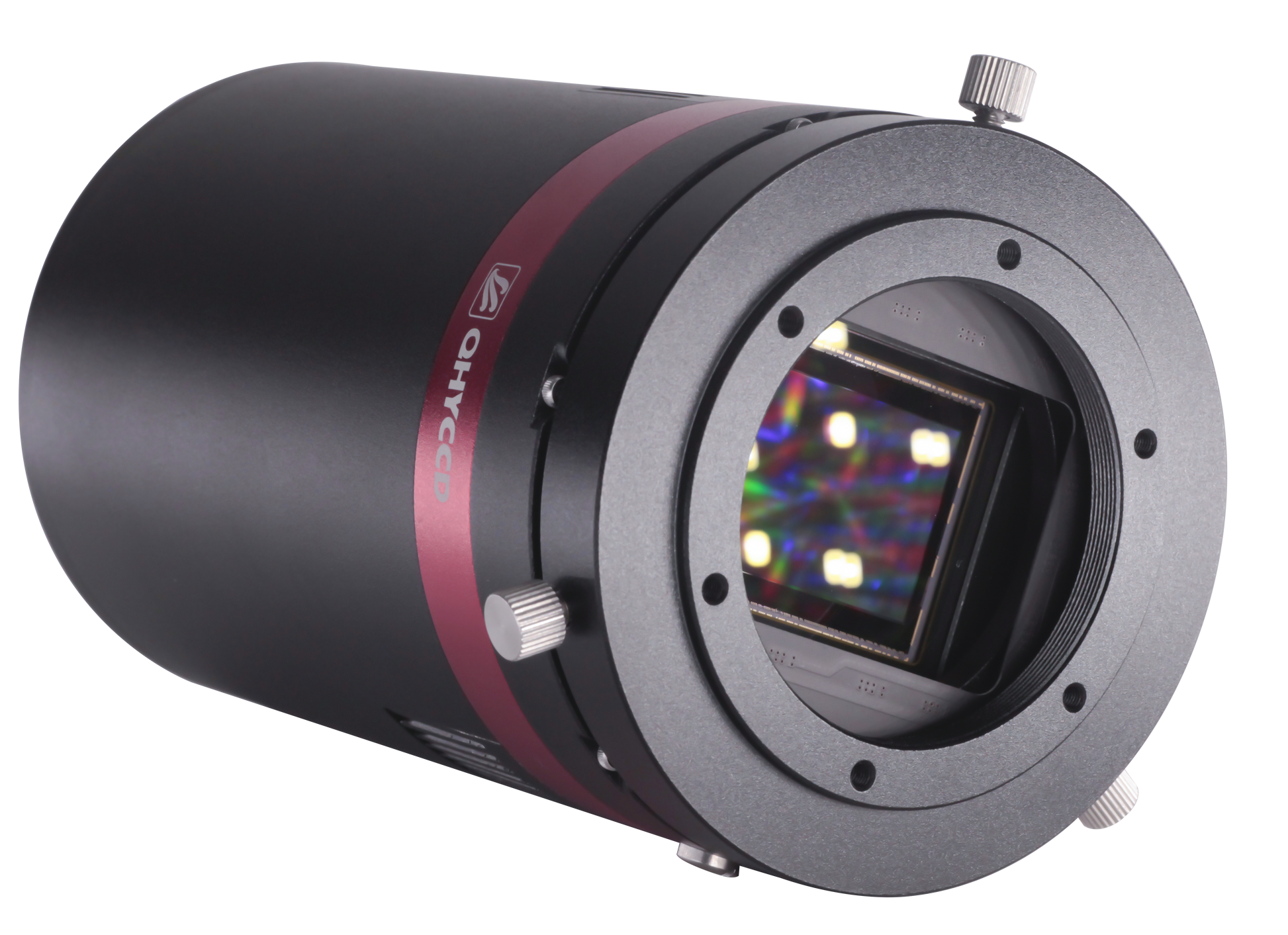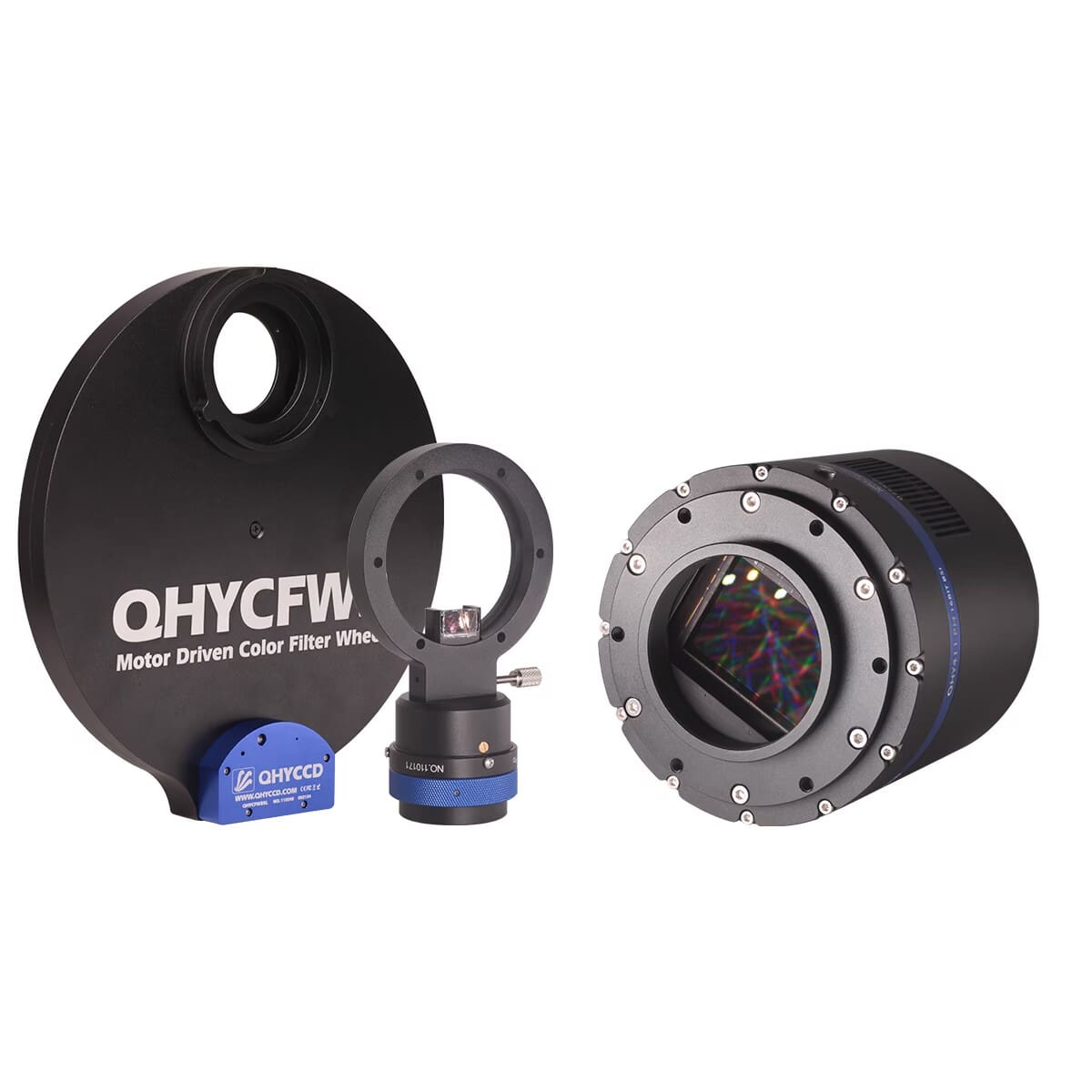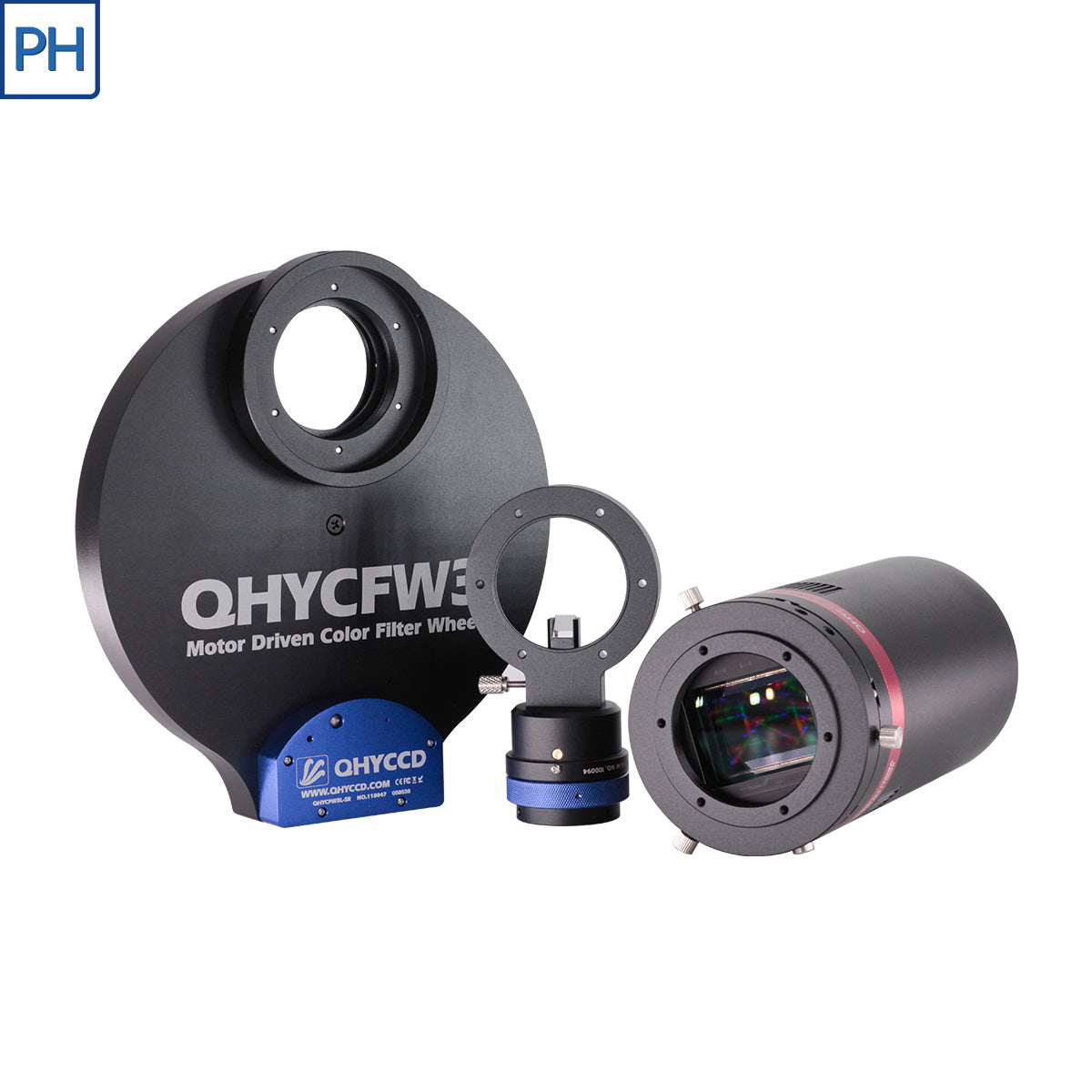QHY600M/C PH
QHY600M/C PH
Couldn't load pickup availability
The QHY600PH Series represents a significant advancement in astronomical imaging. Let’s delve into the features of these cooled CMOS cameras:
-
Sensor and Resolution:
- The QHY600PH Series uses the Sony IMX455 BSI sensor, available in both monochrome (QHY600PH-M) and color (QHY600PH-C) versions.
- This full-frame (35mm format) sensor boasts an impressive 60 megapixels with a pixel size of 3.76μm.
- The native 16-bit A/D conversion ensures high sample resolution and low system gain, resulting in accurate data acquisition.
-
BSI Technology:
- The back-illuminated (BSI) structure of the IMX455 sensor improves its full well capacity.
- In back-illuminated sensors, light enters the photosensitive surface from the reverse side, allowing more photons to strike the photosensitive layer.
- This results in higher quantum efficiency, making the sensor more sensitive to capturing dim objects in the night sky.
-
Low Noise and High Sensitivity:
- The QHY600PH Series achieves extremely low dark current (only 0.002e-/pixel/sec at -20°C) using Sony’s Exmor BSI CMOS technology.
- It exhibits zero amplifier glow and has only one electron of read noise at high gain and full resolution, allowing it to achieve a signal-to-noise ratio (SNR) greater than 3 with just 4 to 6 photons.
- These features make it ideal for sky surveys, time domain astronomy, fluorescence imaging, DNA sequencing, and microscopy.
-
Image Buffer:
- To ensure smooth uninterrupted data transfer of the entire 60MP sensor at high speed, the QHY600PH Series (except QHY600M-PH L) includes a 2GB DDR3 image buffer.
- This large buffer meets the needs of high-speed image acquisition and transmission, reducing pressure on the computer CPU.
-
Liquid Cooling and Other Variants:
- The QHY600PH Series also includes variants such as:
- QHY600PH-M SBFL (short back focal length)
- QHY600PH-C SBFL
- QHY600PH-M LQ (supports liquid cooling)
- The QHY600PH Series also includes variants such as:
In summary, the QHY600PH Series combines high resolution, low noise, and efficient cooling, making it an excellent choice for serious astrophotographers and scientific researchers123. You can find more information about these cameras on the QHYCCD website.
.QHY600 Series have Mutiple models which covers both photographic and scientific using. Below list different types of QHY600 PH (photographic) series:
QHY600PH : Standard version for amateur astrographers;
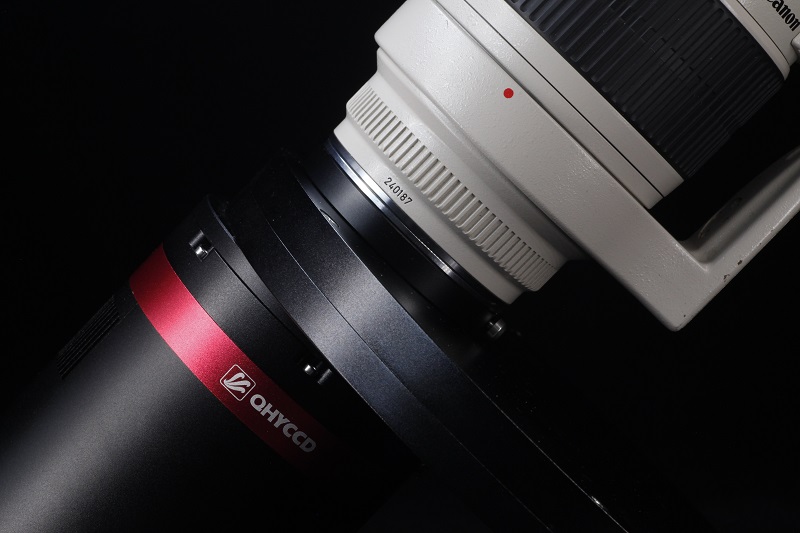 QHY600PH-SBFL (Short back-focal length version) :specially designed for DSLR lens users or those who has special requirement of short back focal length. This version has a special front part version which has 14mm B.F.L only (The B.F.L consumed equals 12.5mm when connecting QHYCFW. About the definition of “BFL Consumed” and our adapter system please view: https://www.qhyccd.com/astronomical-camera-adapter-bfl-solution/). QHY600SBFL can easily match Canon/Nikon lens even with filter wheel. On the side of this adapter there is a 4mm hole to connect air pump through plastic pipe in case of the dewing glass when necessary.
QHY600PH-SBFL (Short back-focal length version) :specially designed for DSLR lens users or those who has special requirement of short back focal length. This version has a special front part version which has 14mm B.F.L only (The B.F.L consumed equals 12.5mm when connecting QHYCFW. About the definition of “BFL Consumed” and our adapter system please view: https://www.qhyccd.com/astronomical-camera-adapter-bfl-solution/). QHY600SBFL can easily match Canon/Nikon lens even with filter wheel. On the side of this adapter there is a 4mm hole to connect air pump through plastic pipe in case of the dewing glass when necessary.
QHY600 Lite
 QHY600L : a lite, shorter and cheaper version. Compared with QHY600PH, QHY600PH-Lite has the following features compared with previous models: QHY600L only has mono version; The body length becomes shorter, which is about 112mm, and its price is lowered compared with QHY600PH; The Built-in DDR3 Buffer (memory storage) is adjusted to 1GB compared to 2GB of QHY600PH/Pro. Other specifications of QHY600L keep the same with QHY600PH except the body length and weight.
QHY600L : a lite, shorter and cheaper version. Compared with QHY600PH, QHY600PH-Lite has the following features compared with previous models: QHY600L only has mono version; The body length becomes shorter, which is about 112mm, and its price is lowered compared with QHY600PH; The Built-in DDR3 Buffer (memory storage) is adjusted to 1GB compared to 2GB of QHY600PH/Pro. Other specifications of QHY600L keep the same with QHY600PH except the body length and weight.
In order to provide smooth uninterrupted data transfer of the entire 60MP sensor at high speed, the QHY600 has 2GB DDR3 image buffer. The pixel count of the latest generation of CMOS sensors is very high resulting in greater memory requirements for temporary and permanent storage. For example, the QHY600 sensor produces about 120MB of data per frame. The data band-width is also increased from the original 16-bits to the current 32-bits. Transferring such a large file sizes necessarily requires the camera to have sufficient memory. The QHY600 has adopted a large-capacity memory of up to 2GB. Data throughput is doubled. This large image buffer meets the needs of high-speed image acquisition and transmission of the new generation of CMOS, making shooting of multiple frames smoother and less stuttered, further reducing the pressure on the computer CPU.
Another advantage is that when using some computers that do not have fast processors or have poor support for USB 3.0, the computer can’t transfer high-speed data well, and the data is often lost. The DDR can buffer a lot of image data and send it to the computer. Even if the USB 3.0 transmission frequently gets suspended, it will ensure that data is not lost. There are options in SharpCap to turn DDR buffering on or off. The current version of the ASCOM driver works in DDR mode.
Native 16 bit A/D: The new Sony sensor has native 16-bit A/D on-chip. The output is real 16-bits with 65536 levels. Compared to 12-bit and 14-bit A/D, a 16-bit A/D yields higher sample resolution and the system gain will be less than 1e-/ADU with no sample error noise and very low read noise.
BSI: One benefit of the back-illuminated CMOS structure is improved full well capacity. This is particularly helpful for sensors with small pixels. In a typical front-illuminated sensor, photons from the target entering the photosensitive layer of the sensor must first pass through the metal wiring that is embedded just above the photosensitive layer. The wiring structure reflects some of the photons and reduces the efficiency of the sensor. In the back- illuminated sensor the light is allowed to enter the photosensitive surface from the reverse side. In this case the sensor’s embedded wiring structure is below the photosensitive layer. As a result, more incoming photons strike the photosensitive layer and more electrons are generated and captured in the pixel well. This ratio of photon to electron production is called quantum efficiency. The higher the quantum efficiency the more efficient the sensor is at converting photons to electrons and hence the more sensitive the sensor is to capturing an image of something dim.
Zero Amplify Glow: This is also a zero amplifer glow camera.
TRUE RAW Data: In the DSLR implementation there is a RAW image output, but typically it is not completely RAW. Some evidence of noise reduction and hot pixel removal is still visible on close inspection. This can have a negative effect on the image for astronomy such as the “star eater” effect. However, QHY Cameras offer TRUE RAW IMAGE OUTPUT and produces an image comprised of the original signal only, thereby maintaining the maximum flexibility for post-acquisition astronomical image processing programs and other scientific imaging applications.
Anti-Dew Technology: Based on almost 20-year cooled camera design experience, The QHY cooled camera has implemented the fully dew control solutions. The optic window has built-in dew heater and the chamber is protected from internal humidity condensation. An electric heating board for the chamber window can prevent the formation of dew and the sensor itself is kept dry with our silicon gel tube socket design for control of humidity within the sensor chamber.
Cooling: In addition to dual stage TE cooling, QHYCCD implements proprietary technology in hardware to control the dark current noise.
You may find some types of thermal noise can change with time in some back-illuminated CMOS cameras. This thermal noises has the characteristic of the fixed position of typical thermal noise, but the value is not related to the exposure time. Instead, each frame appears to have its own characteristics. The QHY600/268/461/411 use an innovative suppression technology that can significantly reduce the apparent level of such noise.
UVLO Protection
UVLO(Under Voltage Locking) is to protect the electronic device from damage caused by abnormally low voltages.
Our daily life experience tells us that the actual operational voltage of an electrical device must not significantly exceed the rated voltage, otherwise it will be damaged. For such precision equipment as cameras, long-term work at too low input voltage can also be detrimental to the working life of the camera, and may even make some devices, such as power manager, burn up due to long-term overload. In the all-in-one driver and SDK after 2021.10.23 stable version, the camera will give a warning when the input voltage of the camera is below 11V.
It is common behavior for a CMOS sensor to contain some horizontal banding. Normally, random horizontal banding can be removed with multiple frame stacking so it does not affect the final image. However, periodic horizontal banding is not removed with stacking so it may appear in the final image. By adjust the USB traffic in Single Frame mode or Live Frame mode, you can adjust the frequency of the CMOS sensor driver and it can optimize the horizontal banding appeared on the image. This optimized is very effective to remove the periodic banding in some conditions.
A typical Periodic Horizontal Noise under certain USB_TRAFFIC values.
After Adjusting the USB Traffic to avoid the periodic horizontal noise.
The camera is designed to use the +12V to reboot the camera without disconnecting and reconnecting the USB interface. This means that you can reboot the camera simply by shutting down the +12V and then powering it back on. This feature is very handy for remote controlling the camera in an observatory. You can use a remotely controlled power supply to reboot the camera. There is no need to consider how to reconnect the USB in the case of remote control.
Multiple Readout Modes
Multiple Readout Modes are special for QHY 16-bit Cameras (QHY600/268/461/411). Different readout modes result in different performance. These readout modes are currently supported in the QHYCCD ASCOM Camera Driver, SharpCap and N.I.N.A.
Readout Mode #0 (Photographic DSO Mode). This mode is suitable for most DSO imaging situations. Since there is a drop in the noise between Gain 25 and Gain 26 (unity gain), we recommend it as default gain setting; however, gain0 is also good enough for a 16-bit sensor.
Readout Mode #1 (High Gain Mode). This mode is something like double native iso of some new digital cameras, whose danamic range can greatly incerase at the vary high iso value, like iso800, iso3200, etc. The high gain mode provide such improvement for QHYCCD 16bit cameras. We recommend you choose this mode when you have to capture at high gain, for example, a vary dark object. Please note the switch point of HGC/LGC of QHY600/268/461 is 56. That means you must set Gain 56 to make the best of it.
Readout Mode#2 (Extended Fullwell Mode). With a pixel size of 3.76um, these sensors already have an impressive full well capacity of 51ke. Nevertheless, QHYCCD has implemented a unique approach to achieve a full well capacity higher than 51ke- through innovative user controllable read mode settings. In Extended Fullwell Mode, the QHY600 can achieve an extremely large full-well charge value of nearly 80ke- and the QHY268 can achieve nearly 75ke-. Greater full-well capacity provides greater dynamic range and large variations in magnitude of brightness are less likely to saturate.
Mode-2CMS
Based on the three basic modes above, 2CMS mode can greatly reduce readout noise by secondary sampling while keeping the same full well value and system gain. We prefer 2CMS modes than basic modes in astrophotography. By the way, the recommend gain values are the same as their basic modes.
Currently QHY600 and QHY461 Series support Extended Fullwell Mode-2CMS (Mode#3), and QHY268 Series support Photographic DSO Mode-2CMS (Mode#4) and High Gain Mode-2CMS (Mode#5). Mode#4 and Mode#5 require Allinone version 20230412 or higher.
| Model |
QHY600PH (Photographic Version)
QHY600PH SBFL (Short Back Focal Length Version) QHY600PH L (Lite Version) |
| CMOS Sensor | SONY IMX455 |
| Mono/Color | Both Available (while Mono only with QHY600PH-L) |
| FSI/BSI | BSI |
| Pixel Size | 3.76um x 3.76um |
| Effective Pixel Area |
9576*6388
(9600*6422 with overscan and optically black area) |
| Effective Pixels |
61.17 Megapixels (effective area. |
| Sensor Size | Full Frame 36mm x 24mm |
|
A/D Sample Depth
|
16-bit (0-65535 levels) at 1X1 binning
18-bit at 2X2, 19-bit at 3X3, 20-bit at 4X4 software binning *QHY600 uses the software digital binning for 2*2binning. With digital sum, 2*2binning will be four 16-bit summed then it is 18-bit. |
| Full Well Capacity (1×1, 2×2, 3×3) |
Standard Mode >51ke- / >204ke- / >408ke- Super Full Well Mode >80ke- / >320ke- / >720ke- |
| Full Frame Rate |
USB3.0 Port Image Transfer Speed
Full Frame Size: 4.0FPS (8-bit output) Full Frame Size: 2.5FPS (16-bit output) 7.2FPS at 9600×3194, 22.5FPS at 9600×1080, 28FPS at 9600×768, 47FPS at 9600×480, 160FPS at 9600×100, Fiber Port Image Transfer Speed (QHY600Pro only) Full Frame Size: 4.0FPS (16-bit output) |
| Readout Noise | 1.0e- to 3.7e- (Standard Mode) |
| Dark Current | 0.0022e-/p/s @ -20C 0.0046e-/p/s @ -10C |
| Exposure Time Range | 40us – 3600sec |
| Unity Gain* |
25 (Extended Full Well Mode) *
*With the improvement of the CMOS technology, the 16bit CMOS camera has been released, like QHY600/268/411/461. For these cameras, even in lowest gain it has beyond the requirement of unit gain (less than 1e/ADU due to sufficient samples) So you can directly set gain 0 as start. Please note QHY600/268C/411/461 has extend full well mode. In this mode you still need to find out the unit gain position. |
| Amp Control | Zero Amplifer Glow |
| Firmware/FPGA remote Upgrade | Supported. Via Camera USB Port |
| Shutter Type | Electric Rolling Shutter |
| Computer Interface | USB3.0 |
| Built-in Image Buffer |
DDR3 memory
PH & PH SBFL ver.: 2GBytes |
| Hardware Frame Sequence Number | Supported |
| Cooling System |
Dual Stage TEC cooler: – Long exposures (> 1 second) typically -35C below ambient – Short exposure (< 1second) high FPS, typically -30C below ambient(Test temperature +20°) |
| Optic Window Type | AR+AR High Quality Multi-Layer Anti-Reflection Coating |
| Anti-Dew Heater | Yes |
| Telescope Interface | M54/0.75 |
| Back Focal Length |
QHY600PH&QHYPH-L: 17.5mm+6mm (±0.2)
QHY600SBFL: 14.5mm* *The BFL Consumed equals 12.5mm when connecting QHYCFW. About the defination of “BFL Comsumed” and our adapter system please view: https://www.qhyccd.com/adapters/ |
| Weight |
PH Version: 850g Lite Version: 790g |
| Power |
40W/100% 20W/50% 13.8W/0% |
Share
